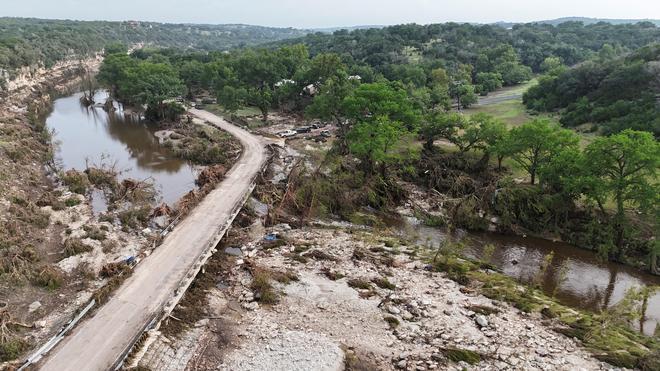The recent catastrophic floods in Texas have left a trail of devastation, with 51 confirmed dead and 27 girls still missing. Rescue workers are navigating the wreckage of homes, roadways, and livelihoods, searching for survivors in the battered communities of Harris, Montgomery, and Liberty counties.
A Disaster Unfolds: The Flood That Changed Everything
Over the weekend, relentless rains overwhelmed Texas’ already saturated ground. Rivers burst their banks and forced thousands to evacuate with little notice. Entire neighborhoods disappeared under murky floodwaters. The power grid faltered. Cell towers went down. For many, it felt like something out of a nightmare.
What makes this flood even more painful is the uncertainty: 27 girls, ranging from 8 to 16 years old, remain unaccounted for. Their families cling to hope, waiting for even the smallest updates from the search teams.
Timeline of Events
- Saturday Morning: National Weather Service issues flash flood warnings across southeast Texas.
- Saturday Afternoon: Rainfall totals surpass 10 inches in a few hours; evacuation orders go out.
- Saturday Night: First fatalities confirmed. Search and rescue teams begin overnight operations.
- Sunday: Authorities confirm structural damage to more than 1,400 homes. Dozens reported missing, most of them children.
- Monday: Death toll rises to 51. Search for 27 missing girls continues as muddy conditions hamper progress.
Official Statements
Texas Governor Greg Abbott addressed the media Monday afternoon in Houston:
“This is a disaster of heartbreaking proportions. Our emergency response teams are doing everything in their capacity to find those who are still missing. Our thoughts are with the families, and the state is deploying all available resources.”
FEMA also announced they are activating federal response protocols and mobilizing additional funding to assist the recovery. Diane Whitley of Harris County Emergency Services called the situation ‘the worst flooding we’ve seen in over a decade.’
Search and Rescue: A Daunting Task
More than 300 rescue workers, supported by local volunteers and the National Guard, are combing through toppled buildings and submerged vehicles. Helicopters circle above while trained canine units and heat scanners comb the debris.
Conditions, though, aren’t on anyone’s side. Flash rains cut off newly cleared roads. Visibility is poor. Some neighborhoods remain completely inaccessible due to high water levels and collapsed infrastructure.
Captain Eli Martinez, leading a search boat in Montgomery County, said, “Every hour that passes makes it harder, but we’re not giving up. We’ll keep working day and night.”
Community Response: Strangers as Lifelines
Amid the despair, there are sparks of humanity. Local churches, schools, and fire stations have transformed into shelters. Neighbors—many of whom lost everything themselves—are helping strangers with food, blankets, and dry clothes.
Houstonians came together in real, tangible ways. Donations are pouring in. Volunteers are on standby with trucks, tools, and even kayaks. Social media channels are flooded with names, photos, and updates in hopes of reuniting families.
Sophia Ellis, a school teacher in Liberty County, shared her home with five displaced families. “I couldn’t just sit and watch. These girls out there — they could be my students. Or my nieces,” she said, her voice calm but tired.
Questions and Concerns: How Did It Get This Bad?
Predicting rain is one thing. Seeing rains of this magnitude hit already vulnerable ground is another. Many residents are now asking: was this preventable?
Local infrastructure has long been criticized for its inability to handle extreme weather. Experts suggest that urban sprawl, poorly maintained levees, and outdated drainage systems contributed massively to the scale of destruction.
Texas has seen more frequent and intense floods in recent years. Is this just the new weather pattern at play—or the result of years of mismanaged urban development? People aren’t convinced either way, but one thing’s clear: this was more than just a bad rainstorm.
What’s Next? The Road to Recovery
The emotional and logistical fallout is only beginning. As of Monday night, over 62,000 homes remain without power. Around 12,000 individuals are living in temporary shelters, with many more staying with friends or family elsewhere.
Federal and state agencies are conducting damage assessments while preparing long-term recovery plans. Financial aid, mental health services, and emergency housing will be rolled out in phases, though no timeline has been confirmed.
But for many parents, none of that matters until the missing girls are found.
You Can Help
If you’re in Texas and can safely volunteer, check with your local emergency operations center. For those outside the area, verified charities such as the American Red Cross and Houston Food Bank are accepting donations, both monetary and material. Clothing, sleeping bags, toiletries, and baby supplies are especially needed.
Right now, it’s about coming together. This isn’t just a regional tragedy—it’s a shared one.
As emergency teams continue their search, the heartache lingers. Hope, though—fragile as it may be—still lives on in every phone call answered, every name checked off the missing list, and every flashlight beam in the dark rubble, seeking signs of life.

